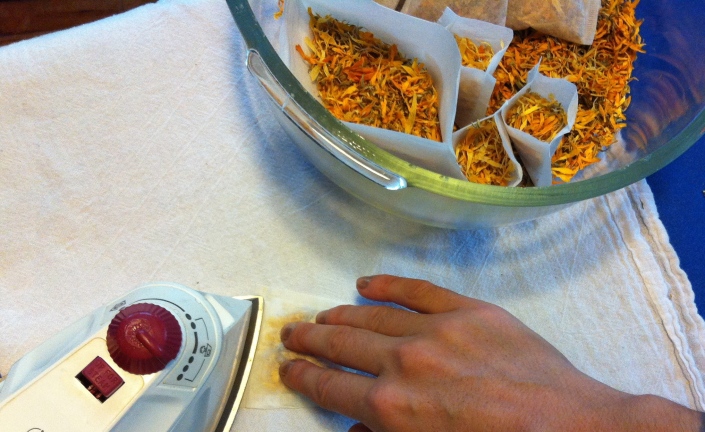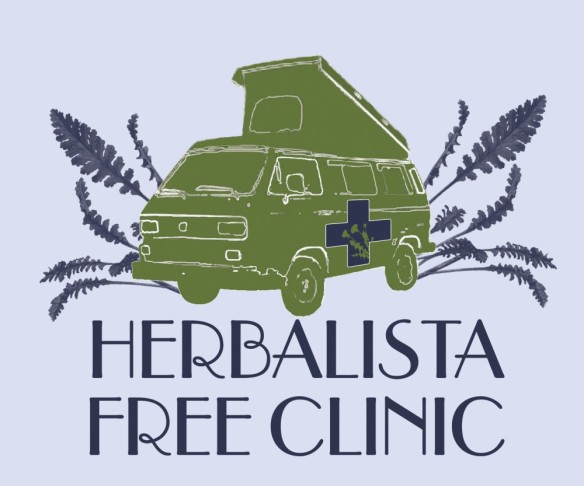Month: January 2013
Herb Dispensing Practicalities — Packaging
 How to dispense the herbs from a mobile clinic to a homeless population with limited funding takes careful consideration, both in terms of ease of use for patients and the cost of packaging.
How to dispense the herbs from a mobile clinic to a homeless population with limited funding takes careful consideration, both in terms of ease of use for patients and the cost of packaging.
TINCTURES/GLYCERITES – For a long time I would only use glass bottles to dispense tinctures, however, after my experience at staffing the Rainbow First Aid Station, Southeast Women’s Herbal Conference Clinic, and Sandy Relief Clinics, I began to use 1 and 2 oz plastic bottles that have a lined cap — no dropper. Droppers and glass tincture bottles are a bit costly, and the plastic bottles with cap come to around 25 cents a piece for a 1 oz and 29 cents for a 2 oz. And while it’s true, I am not the biggest fan of plastic bottles, they do have a few things going for them other than affordability. First, they don’t break, and second, they are much lighter than glass.
And to answer the obvious question of how I control dosage without a dropper– I use the cap as the measuring device. For example, in the 1 oz bottle, the cap holds 4 mils and 1/2 cap holds 2 mils. If I want to do a smaller dose than that, I simply dilute with water. If I fill the bottle with 1/2 tincture formula and 1/2 water, then 1 capful contains 2 mils of tincture and 1/2 capful holds 1 mil.
One bottle holds around 8 capfuls total, so if I am using a drop dosage plant such as anemone, I must decide how many drops I want for each dose and multiply by 9. For example, if I want a 5 drop dosage, I multiply 5 X 8 which equals 40. I place 40 drops in the bottle, fill with water and on the instructions say “Take 1 capful as needed.” It follows that with each capful, the patient is getting 5 drops of anemone. Or if I want more doses in the bottle, I can place 5 X 16 = 80 drops in the bottle, fill the rest with water and say “Take 1/2 cap as needed” and thereby provide 16 individual doses of 5 drops each in the 1 oz bottle.
TEA – Loose tea is an absolute pain in the butt if you don’t have the equipment to make it with ease (such as a french press or kitchen, etc) so I pre bag my teas in hopes that will make it more doable for folks. Enter the iron-shut tea bag, also known as the Press n’ Brew. These are cheap and oh-so-handy. You simply blend your tea, fill the bag, and iron shut. In the picture above, I am preparing calendula tea bags, which do double duty as both an antimicrobial for internal use (as a gentle and tasty anti-fungal for example) or as a compress in first aid for infection. Other such double duty tea bags I keep in stock are chamomile and marshmallow. We can also custom blend personalized tea formulas for clients in the bus, with our electrical hook-up, but it’s a good idea to have commonly used blends already on hand.
People’s Relief Medical Clinic — After Sandy

So the Herb Bus didn’t make the trek up to NYC, but its driver did. I spent some time over the turn of the New Year volunteering with the People’s Relief Free Clinic in the Rockaways and Coney Island. The People’s Relief Free Clinic is a made up of group of health professionals (nurse practitioners, herbalists, doctors, EMT’s, street medics, etc) who came together shortly after the storm to provide medical care for this community when the local government failed them. This grassroots healthcare volunteer collective has been extremely effective, so much so, that they have often been recognized for their work by media, the Red Cross, and even the mayor himself. They were extremely welcoming to this southern herbalist and it was a pleasure to work in such a collaborative environment. I was paired with nurse practitioners and what an incredible team is formed when these different forms of healthcare come together in mutual respect. The patient benefits from full-spectrum care.
Even though Hurricane Sandy hit over two months ago, the pain and damage inflicted on many of the marginalized communities of NYC are still suffering. After seeing patients during the day at the walk-in clinics in the Rockaways and Coney Island, we spent the evening canvasing a 19 story high rise that is still without elevator services. The elderly, disabled, pregnant, and other folks with limited mobility are trapped in their homes, unable to navigate the endless flights of slippery, concrete stairs to get basic food and medical supplies.
For many of the patients we worked with, they had preexisting medical conditions that were severely aggravated by the trauma and stress of the hurricane. I packed a fairly full kit, unsure of what I would be needing to treat, but found the most common complaints were blood pressure issues, pain, asthma, blood sugar imbalances, poor sleep, immune system imbalances, and generalized anxiety. I won’t go into specific case histories and treatment protocols here, but I will say that without a doubt, the favorite “remedy” I handed out were lavender flower filled sachets. There was a complete shift the second their hands closed around the bags and the lavender aroma wafted towards them.
This goes for the other volunteers as well! They have been working so hard over these last couple of months, dealing with such devastation on the daily that their bodies and emotions couldn’t help but also take a toll. I made it a point while at the Rockaway clinic to spend time mixing tonics for the other workers to ease their pains and bolster their spirits. I am honored to be able to have been of service these great healers.
